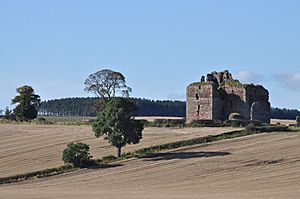Cessford Castle facts for kids
Cessford Castle is an old, ruined castle from the mid-1400s. It's located near a village called Cessford in the Scottish Borders area of Scotland. You can find it between the towns of Jedburgh and Kelso.
This castle was the main home and strong base for the Kerr family. They were known as Border Reivers, who were groups of people living near the border between Scotland and England who often raided each other's lands. Many Kerrs were also "Wardens," meaning they helped keep order in the border areas.
Contents
History of Cessford Castle
Cessford Castle was built around the year 1450. It was built by a man named Andrew Ker. He was an ancestor of later important figures like the Duke of Roxburghe. The Duke of Roxburghe even gets some of his titles, like Baron Ker of Cessford, from this very castle.
How the Castle Was Built
The castle was designed in an "L-plan." This means it had a main tower, called a keep, with another large wing attached to it, making an "L" shape. It was a very strong building, reaching up to six floors high. Two of these floors had strong, rounded ceilings called "barrel vaults."
The walls of the castle were incredibly thick, about 4 meters (13 feet) wide! This made it very hard for enemies to break through. The corner where the two parts of the "L" met was protected by a smaller gatehouse.
Defenses and Attacks
The entire castle was surrounded by a defensive wall called a "barmekin." There were also earthworks, which are mounds of earth used for defense. We know this because during a battle in 1523, English soldiers had to use ladders to climb over these defenses just to get into the castle's yard.
In 1523, a powerful English leader, the Earl of Surrey, attacked the castle. He later said that the castle was so strong, it "might never have been taken" if the defenders had been able to keep fighting. This shows how well-built and tough Cessford Castle was.
When the Castle Was Left Behind
Even though it was very strong, Cessford Castle was eventually left empty. It was abandoned around the year 1650. Today, it stands as a large ruin, showing us a glimpse of its powerful past.



